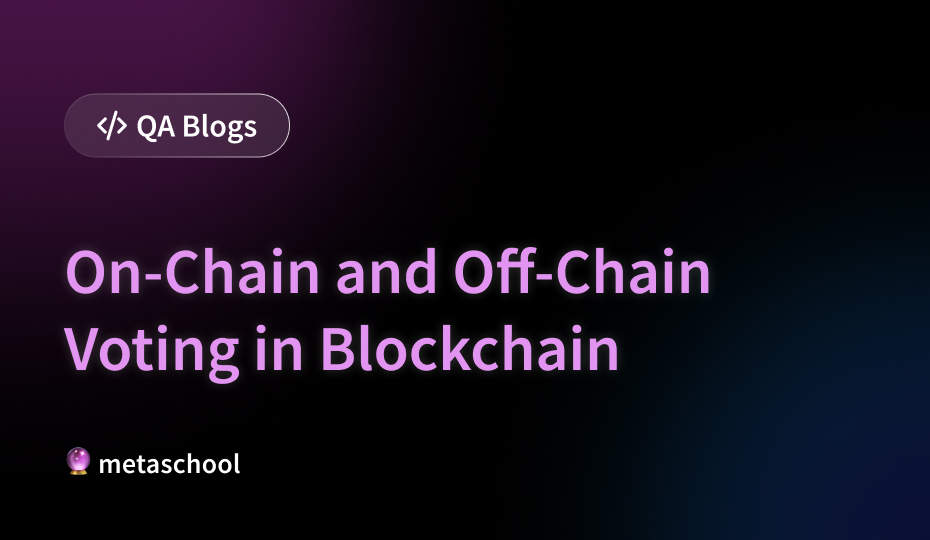Table of Contents
Blockchain technology has the potential to revolutionize voting systems by providing transparent, secure, and tamper-proof mechanisms for recording and tallying votes. Two primary approaches to blockchain-based voting are on-chain and off-chain voting. In this article, we will delve into the concepts of on-chain and off-chain voting, their differences, advantages, and use cases.
Understanding On-Chain Voting
On-chain voting, also known as “voting on the blockchain,” involves recording votes directly on the blockchain, typically through smart contracts or decentralized applications (DApps). Each vote is represented as a transaction on the blockchain, with cryptographic signatures ensuring authenticity and integrity. On-chain voting leverages the transparency and immutability of blockchain technology to provide a tamper-proof record of votes that can be audited by anyone.
Advantages of On-Chain Voting:
- Transparency: On-chain voting provides transparent and publicly verifiable records of votes, enhancing trust and accountability in the voting process.
- Immutability: Once recorded on the blockchain, votes cannot be altered or deleted, ensuring the integrity and security of the voting data.
- Accessibility: On-chain voting can be accessible to anyone with an internet connection and a compatible blockchain wallet, enabling broader participation in the voting process.
- Decentralization: On-chain voting decentralizes the voting process, reducing reliance on centralized authorities and intermediaries and mitigating the risk of manipulation.
Understanding Off-Chain Voting
Off-chain voting, also known as “voting off the blockchain,” involves recording votes using traditional or centralized systems outside the blockchain. While off-chain voting does not directly interact with the blockchain, it may utilize cryptographic techniques to ensure the security and integrity of the voting process. Off-chain voting systems typically rely on trusted third parties or intermediaries to facilitate and verify the voting process.
Advantages of Off-Chain Voting:
- Scalability: Off-chain voting can be more scalable than on-chain voting, as it does not directly impact the blockchain’s processing capacity or transaction throughput.
- Familiarity: Off-chain voting may be more familiar and accessible to users who are accustomed to traditional voting methods, such as paper ballots or electronic voting machines.
- Flexibility: Off-chain voting systems can be customized to meet specific voting requirements and accommodate diverse voting methods, such as ranked-choice voting or proxy voting.
- Regulatory Compliance: Off-chain voting systems may facilitate compliance with legal and regulatory requirements, such as voter identification and eligibility verification, in accordance with local laws and regulations.
Use Cases and Considerations
Use Cases for On-Chain Voting:
- Decentralized Governance: On-chain voting can be used for decentralized governance of blockchain-based protocols, allowing token holders to participate in decision-making processes such as protocol upgrades or parameter adjustments.
- Board Elections: On-chain voting can facilitate transparent and auditable elections for organizations or decentralized autonomous organizations (DAOs), ensuring fairness and accountability in board elections.
Use Cases for Off-Chain Voting:
- Government Elections: Off-chain voting systems may be used for government elections where legal and regulatory requirements mandate certain voting procedures and security measures.
- Corporate Governance: Off-chain voting can be used for corporate governance processes such as shareholder voting or board elections, ensuring compliance with regulatory requirements and corporate governance standards.
Considerations for Both Approaches:
- Security: Both on-chain and off-chain voting systems must prioritize security to protect against manipulation, fraud, and cyber attacks.
- Privacy: Maintaining voter privacy and anonymity is crucial for both on-chain and off-chain voting systems, requiring robust cryptographic techniques and privacy-enhancing technologies.
- Accessibility: Ensuring accessibility for all eligible voters, including those with disabilities or limited access to technology, is essential for both on-chain and off-chain voting systems.
- Scalability: Scalability is a key consideration for both on-chain and off-chain voting systems, particularly as the number of voters and transactions increases.
Conclusion
On-chain and off-chain voting represent two distinct approaches to leveraging blockchain technology for voting systems, each with its own advantages, use cases, and considerations. While on-chain voting offers transparency, immutability, and decentralization, off-chain voting may provide scalability, familiarity, and regulatory compliance. Ultimately, the choice between on-chain and off-chain voting depends on factors such as security requirements, regulatory considerations, and the specific needs of the voting process. As blockchain technology continues to evolve, on-chain and off-chain voting systems have the potential to transform democratic processes, governance mechanisms, and decision-making systems worldwide.
